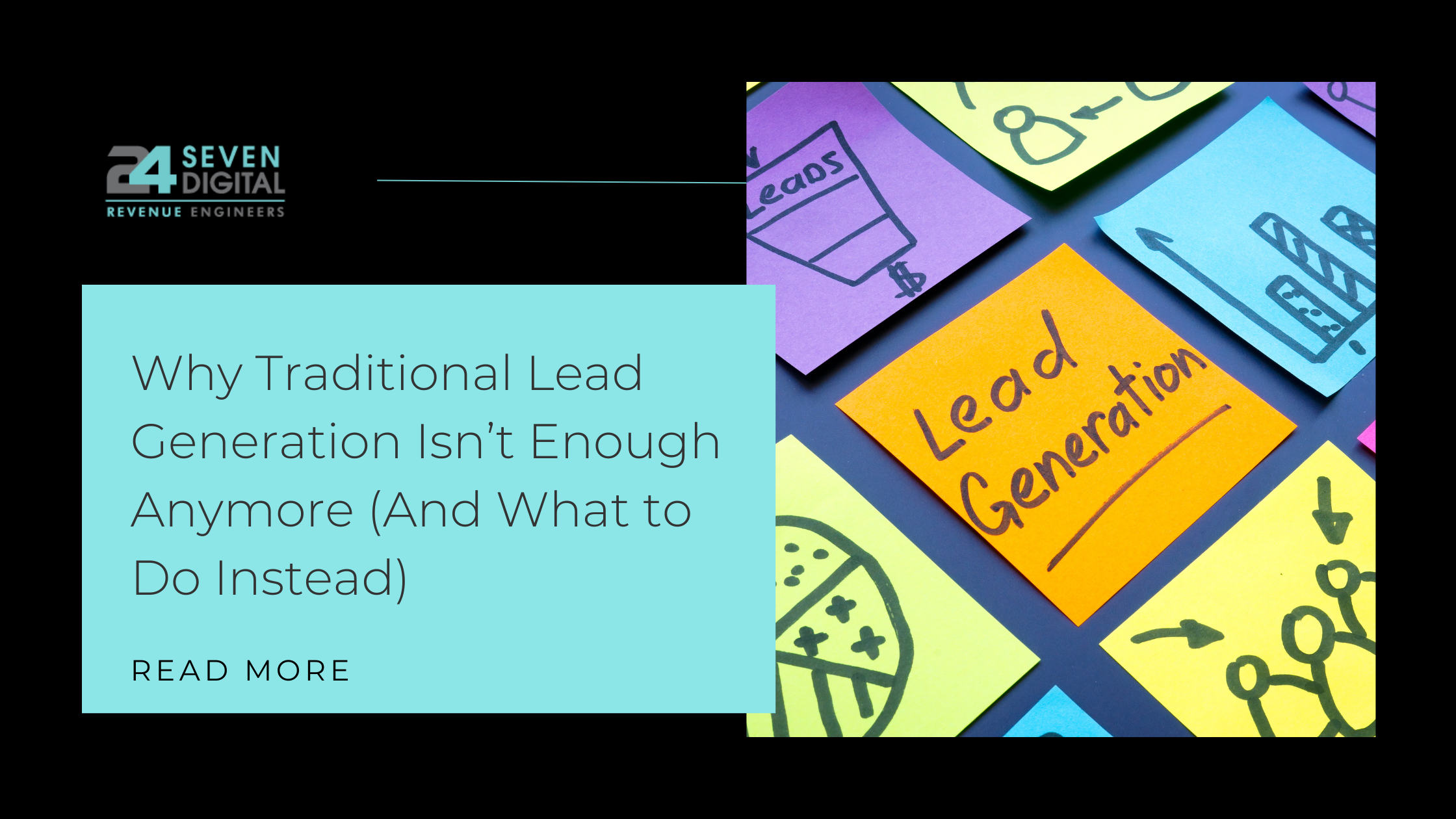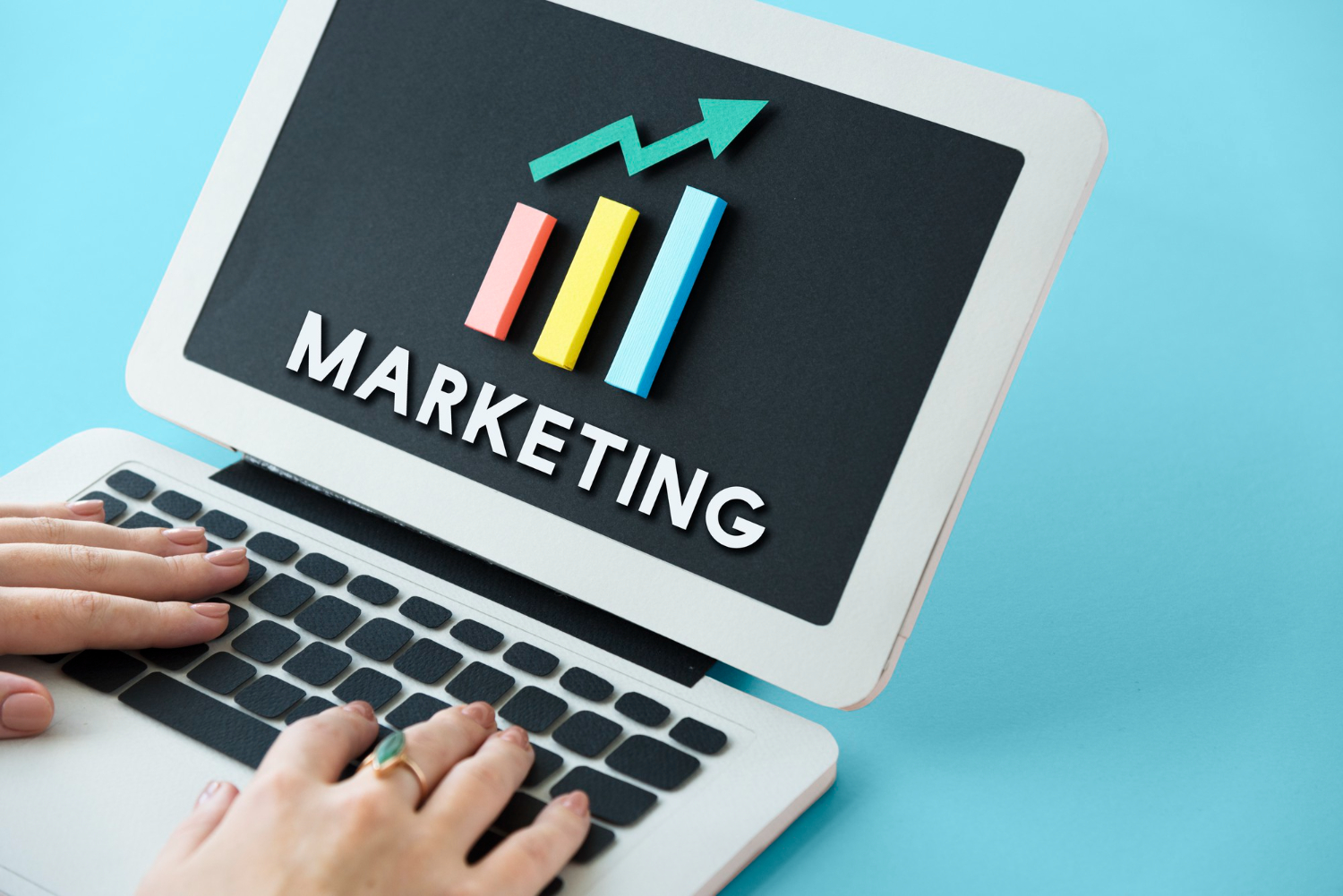
- Traditional lead generation tactics often fail because they interrupt rather than engage, ignoring how modern buyers research and make decisions.
- Demand generation prioritizes trust, education, and alignment between marketing and sales, creating lasting relationships instead of one-off leads.
- 24 Seven Digital supports businesses in building thoughtful, data-informed marketing strategies that deliver genuine value and sustainable growth.
Lead generation has long been a staple of business growth strategy. It once meant buying lists, cold-calling, sending generic emails, hosting events with broad appeal, or running display ads hoping for a click. For decades, these methods delivered steady streams of contacts that sales teams could pursue. But business has changed, and so have buyers.
Prospects no longer respond to the same old tactics. They research on their own terms. They expect tailored, relevant, trustworthy experiences before they consider sharing their information. Traditional lead generation approaches have been outpaced by shifts in technology, customer expectations, and competitive pressures.
Businesses relying solely on outdated tactics risk wasting budgets, alienating buyers, and falling behind competitors who are meeting prospects where they are—with real value, genuine engagement, and smarter targeting.
This shift isn’t a passing trend. It’s the reality of a market saturated with choice and information. To succeed, organizations must move beyond lead “capture” to lead development, nurturing authentic, data-informed relationships that drive meaningful growth.
Below, let’s examine why traditional lead generation methods are falling short, what businesses should do instead, and how to build a sustainable, effective strategy for modern buyer expectations.
The Decline of Traditional Lead Generation
Lead generation used to be a numbers game. Buy a list, send thousands of emails, call everyone, and advertise broadly. The logic was simple: the more people you reached, the more likely some would respond.
But this approach depends on interrupting people. It doesn’t account for the fact that customers have more control than ever over how they interact with brands. They unsubscribe. They block. They ignore. And why wouldn’t they? These traditional methods often fail to offer anything of real value.
Buyers are Savvier
People don’t want spam. They want solutions. They want to research at their own pace, on their own terms. They want relevant information that helps them understand whether you’re the right fit. Old-school methods don’t support this journey; they try to skip to the sale before trust has formed.
Noise and Clutter
Generic lead generation tactics contribute to an overwhelming volume of marketing noise. Prospects are bombarded with irrelevant offers, aggressive follow-ups, and generic content. The result? They tune it out. Even high-volume approaches that used to work are delivering diminishing returns.
Privacy and Compliance
Data privacy rules have tightened. Regulations like GDPR and CCPA restrict how businesses can collect and use personal data. Buying contact lists and blasting emails to people who didn’t opt in can lead to penalties and damage your brand’s reputation.
Misalignment Between Marketing and Sales
Traditional lead generation often creates tension between marketing and sales. Marketing teams deliver a large volume of poorly qualified leads. Sales teams get frustrated chasing people who aren’t a good fit. This misalignment reduces efficiency and increases costs.
The Evolving Buyer Journey
At the center of this shift is the modern buyer. They don’t want to be “sold to” in the old sense. They want to feel understood. They want to evaluate options thoroughly. They want brands to prove their value before they even consider making contact.
Self-Directed Research
The buying journey has become longer and more self-directed. People do extensive online research before they ever fill out a form or take a sales call. They’re reading reviews, checking social proof, comparing competitors, and consuming content that educates them on their challenges and opportunities.
Trust and Authenticity
Trust is currency. Buyers reward brands that demonstrate expertise, transparency, and an authentic desire to help. They’re wary of those who appear only interested in closing a deal. Content marketing, social engagement, and meaningful conversations build this trust over time.
Personalization Expectations
Generic messages get deleted. Personalized, relevant experiences get attention. Buyers expect that companies will understand their industry, role, pain points, and goals and tailor their outreach accordingly. Traditional lead generation’s one-size-fits-all approach doesn’t deliver this.
Longer Decision Cycles
Complex purchases often involve more decision-makers, more scrutiny, and more time. Winning these deals requires ongoing nurturing, helpful content, and patience, far beyond the scope of traditional lead generation campaigns.
What to Do Instead: Build Sustainable Demand Generation
Replacing traditional lead generation doesn’t mean abandoning the goal of finding new customers. It means shifting from a transactional mindset to a relationship-based approach that focuses on long-term growth and genuine engagement.
Focus on Value, Not Volume
Success today is less about reaching everyone and more about reaching the right people with the right message. That means creating resources that truly help your target audience solve problems, make decisions, and see you as a trusted partner.
Content marketing is key here: blogs, white papers, videos, podcasts, webinars, and interactive tools that educate and inform. This content attracts qualified prospects organically and nurtures them through the buyer journey.
Align Sales and Marketing
Demand generation requires seamless collaboration between marketing and sales. Instead of marketing handing off cold or poorly qualified leads, both teams should agree on what a qualified lead looks like, how to score and prioritize leads, and how to nurture them effectively.
Marketing can help sales by warming up prospects with relevant content and engagement, so sales conversations are more productive and better targeted.
Adopt an Inbound Strategy
Inbound marketing focuses on attracting customers through valuable content and experiences tailored to them, rather than pushing out interruptive messages. When done well, inbound creates a steady flow of engaged, qualified prospects who want to talk to you.
This approach aligns with how buyers actually behave: researching online, seeking helpful resources, and reaching out when they’re ready.
Leverage Data and Technology Thoughtfully
Modern lead development depends on data, but data isn’t useful if it’s sloppy, outdated, or misused. Instead of buying lists, companies should focus on building and maintaining their own high-quality, permission-based data sources.
Marketing automation platforms and CRM systems enable businesses to:
- Track prospect behavior across channels
- Score leads based on engagement and fit
- Automate personalized nurturing sequences
But automation shouldn’t mean spam. The best strategies use data to understand what content a prospect cares about, when they’re most likely to respond, and how best to support them in their journey.
Personalize at Scale
Personalization doesn’t have to be one-to-one in the manual sense. With thoughtful use of marketing technology, companies can deliver tailored experiences at scale. This might mean dynamic email content based on segment, website personalization, or retargeting campaigns that reflect specific buyer interests.
Buyers respond when they feel seen and understood, when your outreach aligns with their industry, role, challenges, and stage in the decision process.
Invest in Brand and Trust
Lead generation is often treated as purely tactical: get X number of leads to hit the target. But strong demand generation is strategic. It builds the brand over time, so that when a prospect is ready to buy, you’re the clear choice.
Thought Leadership
Establishing credibility in your industry through insightful content, speaking engagements, social media, and partnerships positions your brand as the go-to resource. It makes prospects more likely to engage proactively, reducing the need for outbound chasing.

Customer Advocacy
Referrals, testimonials, case studies, and user-generated content are powerful forms of social proof. They show potential customers that people like them have succeeded with your help. Traditional lead gen often ignores this channel, focusing only on net new cold leads.
Consistency and Patience
Building trust doesn’t happen overnight. Companies need to commit to consistent, high-quality content and engagement that demonstrates their expertise and empathy for customer challenges. The result is a pipeline of qualified leads who see you as a partner, not a pest.
Measure What Matters
One reason traditional lead generation persists is that it’s easy to measure the wrong things. It’s simple to count email sends, calls made, and leads acquired. But these metrics don’t capture what actually drives revenue.
Instead, companies should focus on metrics that reflect real progress:
- Pipeline contribution
- Marketing-sourced revenue
- Customer acquisition cost (CAC)
- Customer lifetime value (CLV)
- Lead-to-customer conversion rates
This shift in measurement helps marketing and sales teams focus on quality over quantity and prioritize strategies that deliver real business outcomes.
Embrace a Customer-Centric Culture
Ultimately, the move beyond traditional lead generation is about adopting a customer-centric mindset. Instead of asking “How do we get more leads fast?”, the question becomes “How do we help our ideal customers succeed?”
Businesses that answer this well don’t need to rely on intrusive, high-volume tactics. They earn trust and interest by demonstrating genuine understanding, delivering consistent value, and supporting prospects at every step of the journey.
This cultural shift requires leadership buy-in, cross-functional collaboration, and a willingness to invest for the long term. But the payoff is sustainable growth, stronger customer relationships, and competitive differentiation that’s hard to replicate.
What Successful Companies Are Doing Differently
Look at companies leading the way in demand generation, and you’ll see some consistent patterns.
They invest heavily in understanding their buyers through research, surveys, interviews, and data analysis. They create detailed buyer personas that go beyond demographics to include motivations, challenges, and buying triggers.
They build content ecosystems designed to serve buyers throughout their journey. Rather than relying on a single eBook download as a lead source, they offer an interconnected library of resources, from introductory blog posts to advanced guides and case studies.
They nurture leads carefully. Instead of rushing to hand off a contact to sales, they use email workflows, retargeting, and other channels to deliver helpful, relevant content over time.
They maintain high standards for data quality. Purchased lists and scraped emails are replaced with permission-based, well-maintained contact databases that enable personalized, compliant marketing.
They measure success based on revenue impact, not vanity metrics. Instead of celebrating lead volume alone, they align marketing and sales around pipeline contribution and closed-won deals.
Adapting Your Strategy for Sustainable Growth
Transitioning away from traditional lead generation doesn’t mean you abandon outbound entirely. Instead, you integrate it thoughtfully into a broader demand generation approach.
Cold outreach still has a role, but it should be highly targeted, personalized, and timed based on buying signals. Advertising remains important, but it should be tailored, relevant, and aligned with a compelling content strategy.
The key is integration. All channels and tactics should work together to support the customer’s journey. Sales, marketing, and service should share data and insights to deliver a seamless experience.
Success depends on adopting a long-term view. The companies that thrive recognize that brand, trust, and customer relationships are their most valuable assets, and they treat lead generation as an opportunity to strengthen these foundations.
Conclusion
Traditional lead generation methods are losing their effectiveness because they fail to respect how people want to buy. The new approach centers on building trust, delivering consistent value, and meeting customers where they are in their journey.
By investing in demand generation strategies that prioritize education, personalization, and long-term relationships, businesses can create a sustainable competitive advantage, one built on understanding and serving their customers better than anyone else.
Explore smarter approaches to connecting with your audience. At 24 Seven Digital, we help you rethink strategy with meaningful, data-informed marketing that supports lasting relationships. Build trust and deliver genuine value that resonates with your ideal customers. Contact us to learn more today.
